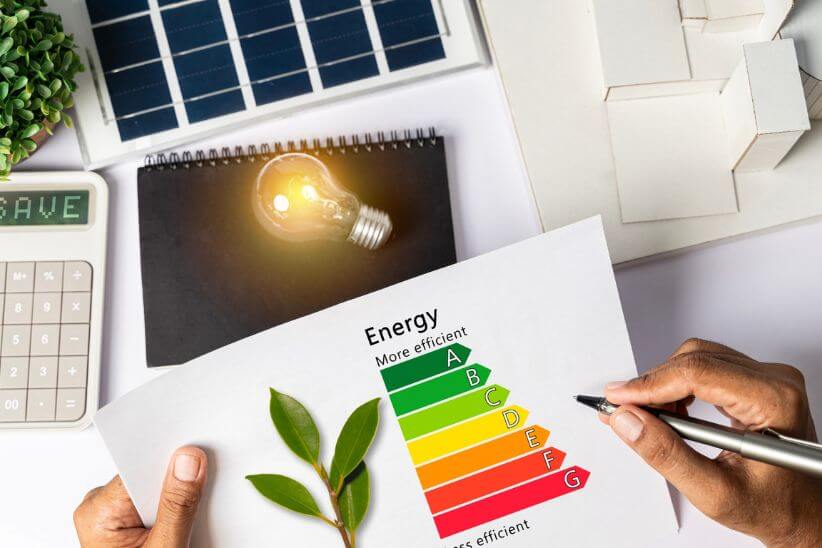
I’m taking a week away from our Q and A about solar panels etc to look at a lightbulb and it’s part in this story.
Remember when incandescent light bulbs were our ‘ordinary’ lighting? You could buy them in ‘sizes’ like 40W, 60W or 100W. A bigger number in front of the ‘W’ meant we got more light.
Over time, as electricity prices have increased and technology has advanced, new kinds of lightbulbs have been developed that use much less electricity to provide the same amount of light for us.
I’ve created a little table that may be helpful here. It’s based on the light produced by a 60W incandescent bulb.
| Watts used | Light bulb |
| 60w | incandescent |
| 42w | halogen |
| 15w | CFL |
| 8-12w | LED |
It shows that an 8w LED (light emitting diode) bulb can produce as much light as a 60w incandescent bulb could.
So, why is this important?
Well, the ‘W’ never did mean the light produced by the bulb. It means the amount of electricity used to produce the light.
And now that electricity is getting very, very costly (and uses non-renewable resources but that’s another story for another time) so it makes sense to look for ways to reduce our use.
Before I continue on about the story of the Watt I have another question to answer.
Hopefully you can see that watts are no longer a good way to think about lighting. But, if watt don’t tell me how much light I’m getting, what does?
The simple answer is something completely new to me until quite recently. How did I get through high school science without knowing this? But that aside, the answer is —–
A LUMEN
A ‘lumen’ comes from the Latin word for light. It is a measure not of the electricity used but of the total quantity of visible light emitted from a light source.
Now, back to the table, I can add another column like this
| Watts used | Light bulb | Lumens |
| 60w | incandescent | 800 |
| 42w | halogen | 800 |
| 15w | CFL | 800 |
| 8-12w | LED | 800 |
From now on you can look for the amount of brightness in your lights by checking the lumens and then check for the bulb with the lowest watts to reduce your electricity bill.
The next page returns to watts and why understanding watts is so very important to us.
To start with, what is a watt?
“Power is a measure of the rate at which energy flows, and in electrical systems it is measured in watts (W). Watts are basically the miles-per-hour measurement of the electrical world–they tell you how fast the electrons are speeding down the highway.? (cited on https://www.buildinggreen.com/news-article/what-watt-anyway-understanding-energy-and-power-metrics)
I suspect most of you can now guess that a kilowatt is one thousand watts. In incandescent light bulb terms, it is the electricity used by 10 100W bulbs. But there’s another term related to kilowatts that we also need to understand now.
I’ve been mentioning kw (for kilowatt) and kwh (for kilowatt hour) in my previous two articles and now is the time to understand them and their difference. Kind of backwards I know! My apologies for that. The article I quote above also describes well what a kilowatt hour is.
“When you get your utility bill, the electricity you’ve used is measured in kilowatt -hours (kWh). While a watt is a measure of power, a kWh is a measure of energy. Energy is defined as the capacity to do work, such as creating heat, light, or motion. If you run a 60-watt lightbulb for one hour, you’ve used 60 watt-hours, or 0.06 kilowatt-hours, since a kWh is 1,000 watt-hours. In other words, 0.06 kWh is the amount of energy you need to run a lightbulb for an hour.” (cited on https://www.buildinggreen.com/news-article/what-watt-anyway-understanding-energy-and-power-metrics)
It’s interesting that this article, like I did, went to the incandescent light bulb for help with its explanation. Let us return to my kilowatt explanation.
If a kilowatt is the rate of electricity used by 10 – 100W incandescent lightbulbs, those same lightbulbs would ‘consume’ 1 kilowatt hour (1kwh) if they were on for one hour. That is the ‘energy’ needed to keep them running, just like you need to consume energy (calories) to keep on walking or running.
[Imagine a photo here of the Mallacoota Fun Run ]
Reading your electricity bill
I’ve previously asked you to get used to reading your electricity bill and understanding what it is saying.
As your ‘consumption’ is measured in kwh (1000watthours), this discussion on kw and kwh is essential for understanding what you are looking at.
You will find your average daily usage on your bill somewhere.
You are likely paying between a low of $.19 per kilowatthour and a high somewhere close to $.40/kwh.
If you think it might help you, look at how many kwh you used in the period of your bill and think about it in terms of how many 100W bulbs for how many hours. This might get things into a size you can imagine.
I’m going to leave it here for this week and be back to more questions next issue.
Turning off the lights now!
Tricia